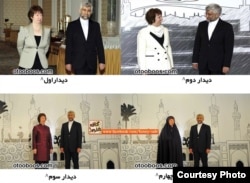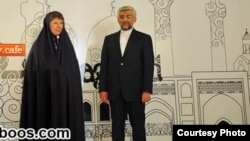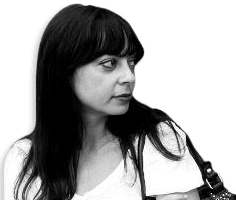While the eyes of many pundits, policymakers, journalists, and Iranian citizens were glued to reports emerging from this week's nuclear talks in Baghdad, some Iranians were focusing their attention on what European Union foreign policy chief Catherine Ashton, who led the meetings on behalf of the 5+1 group, was wearing.
Their jest that Ashton might turn up in a black chador on the second day of talks didn’t materialize. Instead, the EU leader wore a demure brown top that showed little of her neckline.
Iranian media and followers of social media have suggested that Ashton was dressing more conservatively than at her last meeting with Iranian authorities, in Geneva last year.
In photographs from those talks with Iran’s top nuclear negotiator, Said Jalili, Ashton is wearing a black blouse that is apparently too revealing for Iranian newspapers. They retouched the picture, raising the neckline to make it acceptable for the official standards of the Islamic republic.
The practice is common among Iranian newspapers to avoid trouble and possible warning and closure by authorities.
Then, during last month's nuclear talks in Istanbul, Ashton was seen in official pictures next to Jalili wearing a black suit with a white scarf tucked around her neck.
That brought praise from Iran’s state television, which suggested that Ashton had made an effort to respect a “special” dress code in her meetings with Iranian officials.
The scarf was also noticed by Iranian news sites, including the conservative “Tabnak,” which said her appearance showed that Ashton respects the customs and traditions of Iran. “In fact, Ashton’s move was a positive step which demonstrated that the status of the Islamic republic is important for her and the West,” the site's editors commented.
During this week's round of talks in the Iraqi capital, Ashton went a step further. For her first day of meetings with Jalili, she wore a long, burgundy-colored jacket with a tight collar -- the kind of thing she could easily wear on the streets of Tehran (with the addition of a scarf to cover her hair) without getting arrested by the morality police.
The conservative outfit prompted some observers to predict wryly that for the second day of talks with Jalili, Ashton would turn up in a black chador -- the cloak that covers the entire body and that Iranian officials consider the most preferable type of hijab.
“Is Ashton becoming a Chadori?” asked one Iranian on Facebook. Another person wrote that Ashton would be welcomed in the city of Qom, which is home to religious seminaries and senior clerics.
Male-female relations are a delicate matter in Iran, where diplomats and officials generally don't shake the hands of their female counterparts. Under Islamic guidelines as they are enforced in Iran, men and women who are not related cannot shake hands and should also avoid prolonged eye contact. Some Iranian officials and conservatives don’t even look at a woman’s face while talking to them.
Ashton is trying to avoid offending Iranians officials, lest her attire take the focus off the business at hand, says a London-based former Iranian diplomat, Mehrdad Khonsari.
“Westerners, particularly Ashton, pay attention to the [sensitivities] of Iranian officials so that there is no excuse for things to go wrong and the main issue to go off track,” Khonsari says.
Ashton appears to have succeeded on all counts in Baghdad.
She announced on May 24 that a new round of talks between Iran and world powers would be held in June in Moscow on June 18-19. "Iran declared its readiness to address of issue of 20-percent [uranium] enrichment and came with its own five-point plan, including their assertion that we recognize their right to enrichment," she said after the meetings.
Unprecedentedly tough international sanctions and the threat of military strikes are being credited with bringing Iran back to the negotiating table.
It’s unclear to what extent, if any, Ashton’s dress diplomacy has helped keep negotiations alive.
But one thing is clear: In the upcoming Moscow talks, her décolletage -- or lack thereof -- will again take center stage.
-- Golnaz Esfandiari
Their jest that Ashton might turn up in a black chador on the second day of talks didn’t materialize. Instead, the EU leader wore a demure brown top that showed little of her neckline.
Iranian media and followers of social media have suggested that Ashton was dressing more conservatively than at her last meeting with Iranian authorities, in Geneva last year.
In photographs from those talks with Iran’s top nuclear negotiator, Said Jalili, Ashton is wearing a black blouse that is apparently too revealing for Iranian newspapers. They retouched the picture, raising the neckline to make it acceptable for the official standards of the Islamic republic.
The practice is common among Iranian newspapers to avoid trouble and possible warning and closure by authorities.
Then, during last month's nuclear talks in Istanbul, Ashton was seen in official pictures next to Jalili wearing a black suit with a white scarf tucked around her neck.
That brought praise from Iran’s state television, which suggested that Ashton had made an effort to respect a “special” dress code in her meetings with Iranian officials.
The scarf was also noticed by Iranian news sites, including the conservative “Tabnak,” which said her appearance showed that Ashton respects the customs and traditions of Iran. “In fact, Ashton’s move was a positive step which demonstrated that the status of the Islamic republic is important for her and the West,” the site's editors commented.
During this week's round of talks in the Iraqi capital, Ashton went a step further. For her first day of meetings with Jalili, she wore a long, burgundy-colored jacket with a tight collar -- the kind of thing she could easily wear on the streets of Tehran (with the addition of a scarf to cover her hair) without getting arrested by the morality police.
The conservative outfit prompted some observers to predict wryly that for the second day of talks with Jalili, Ashton would turn up in a black chador -- the cloak that covers the entire body and that Iranian officials consider the most preferable type of hijab.
“Is Ashton becoming a Chadori?” asked one Iranian on Facebook. Another person wrote that Ashton would be welcomed in the city of Qom, which is home to religious seminaries and senior clerics.
Male-female relations are a delicate matter in Iran, where diplomats and officials generally don't shake the hands of their female counterparts. Under Islamic guidelines as they are enforced in Iran, men and women who are not related cannot shake hands and should also avoid prolonged eye contact. Some Iranian officials and conservatives don’t even look at a woman’s face while talking to them.
Ashton is trying to avoid offending Iranians officials, lest her attire take the focus off the business at hand, says a London-based former Iranian diplomat, Mehrdad Khonsari.
“Westerners, particularly Ashton, pay attention to the [sensitivities] of Iranian officials so that there is no excuse for things to go wrong and the main issue to go off track,” Khonsari says.
Ashton appears to have succeeded on all counts in Baghdad.
She announced on May 24 that a new round of talks between Iran and world powers would be held in June in Moscow on June 18-19. "Iran declared its readiness to address of issue of 20-percent [uranium] enrichment and came with its own five-point plan, including their assertion that we recognize their right to enrichment," she said after the meetings.
Unprecedentedly tough international sanctions and the threat of military strikes are being credited with bringing Iran back to the negotiating table.
It’s unclear to what extent, if any, Ashton’s dress diplomacy has helped keep negotiations alive.
But one thing is clear: In the upcoming Moscow talks, her décolletage -- or lack thereof -- will again take center stage.
-- Golnaz Esfandiari








